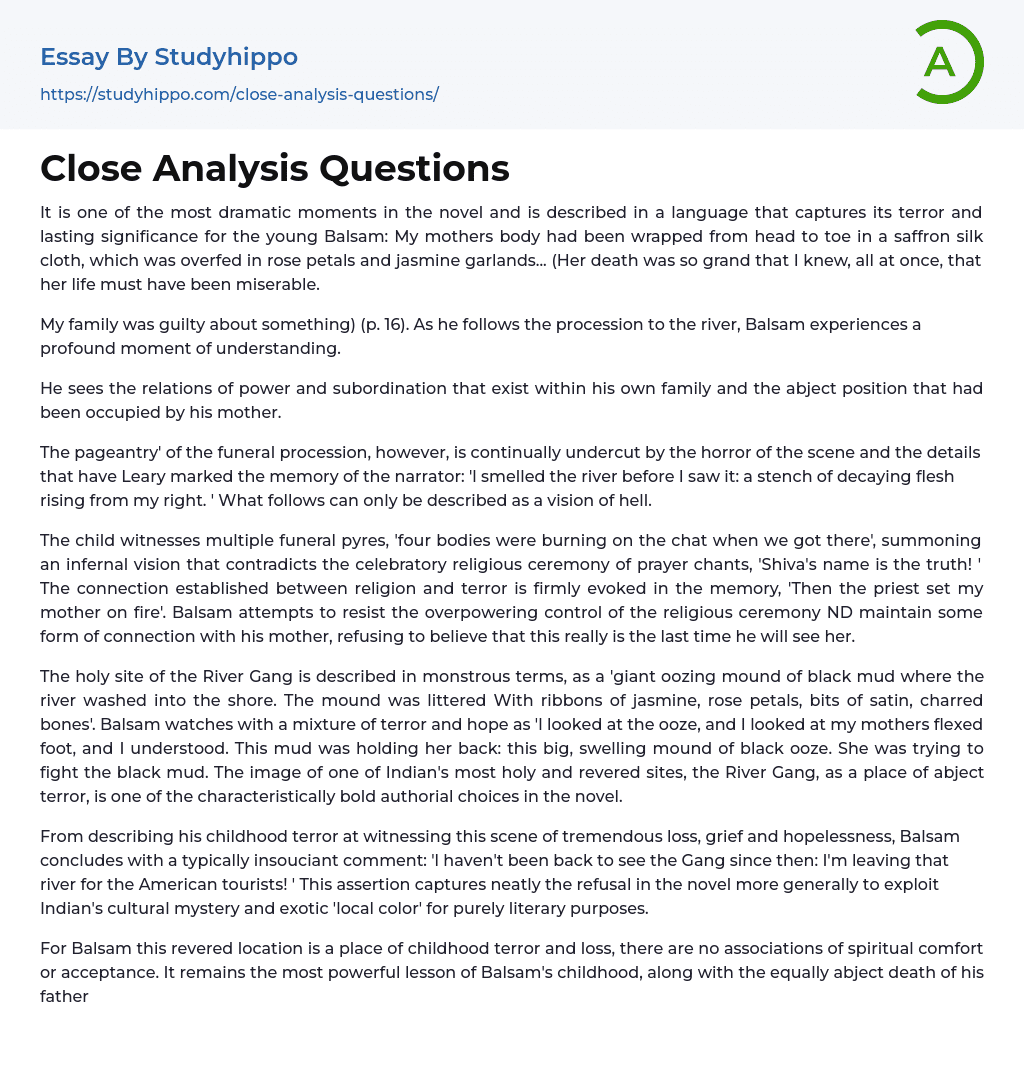In the novel, there is a dramatic moment that deeply impacts the young Balsam. His mother's body is wrapped in a saffron silk cloth covered in rose petals and jasmine garlands, creating a grand funeral procession. However, he can sense the guilt present in his family and understands that his mother's life must have been miserable. As Balsam follows the procession to the river, he becomes aware of the power dynamics and subordination that existed within his family, as well as his mother's abject position. Although the funeral pageantry is impressive, the horrific details of the scene are marked in Balsam's memory. He recalls the smell of decaying flesh coming from the river and sees multiple funeral pyres burning with bodies. The joyous religious ceremony of prayer chants, which exclaim "Shiva's name is truth," is contradicted by this
...infernal vision. The connection between religion and terror is firmly established as the priest sets Balsam's mother on fire during the funeral.In an attempt to maintain a connection with his mother and resist the overpowering control of a religious ceremony, Balsam refuses to believe that this will be the last time he sees her. The River Gang, one of India's most holy sites, is described in monstrous terms as a "giant oozing mound of black mud" with scattered ribbons of jasmine, rose petals, bits of satin, and charred bones. Balsam is filled with terror and hope as he observes the mud holding back his mother's flexed foot. The novel makes characteristically bold authorial choices in portraying the River Gang as a place of abject terror and hopelessness, describing Balsam's childhood experiences of witnessing tremendous loss and grief.
Despite this, Balsam concludes with an insouciant comment about leaving the river for American tourists. The novel refuses to exploit India's cultural mystery and exotic "local color" for purely literary purposes. For Balsam, the revered location is associated only with childhood terror and loss; there are no feelings of spiritual comfort or acceptance.Balsam's childhood taught him powerful lessons, including the traumatic death of his father in an unattended hospital ward. The scene challenges readers' preconceptions about the religious character of India and raises questions about Taiga's intentions in depicting a contrasting vision of religious ceremony and belief. When Balsam watches his mother's foot resist black ooze, he claims to have understood something that becomes more apparent later in the narrative when he faces similar questions of life and death, family duty, and personal survival. The death of Balsam's mother is a compelling rejection of caste and the ceremonial justifications for its continuance as an integral part of Indian cultural identity. Balsam refers to the Rooster Coop as the greatest thing to come out of India's ten thousand year history when addressing Mr. Ojibwa. The Rooster Coop is a powerful metaphor that recurs throughout the novel to depict the deeply entrenched forces and social arrangements that prevent personal rebellion or escape from poverty or oppression.Balsam uses vivid language to describe the conditions in the rooster coop, where roosters are surrounded by the blood and organs of their slaughtered brethren, creating a sense of fear and resignation. Balsam emphasizes that this same phenomenon occurs with human beings in India, where poverty and the caste system force people into a state of servitude, leading to collective passivity and
subordination. He argues that the rooster coop is a pervasive pattern in Indian society that allows corruption to go unchallenged. Balsam suggests that the rooster coop metaphor is a powerful way of understanding the dehumanizing effects of poverty and social oppression in India.According to page 175, the entire Indian economy relies on the trustworthiness of servants. The novel portrays the prevalent corruption witnessed by Balsam during his employment with Mr. Shook. Mr. Shook's betrayal of Balsam when he is blamed for Pinky's accident further highlights the importance of the Rooster Coop in maintaining corrupt families such as the Storks. The Rooster Coop is a metaphor for India's archaic culture and the waste of human potential. It is imperative for the nation to abandon the Rooster Coop, not only by exceptional servants like Balsam, but also by the nation itself. The metaphor of the Rooster Coop amalgamates many central concerns of the novel. Balsam explains his ability to see the reality of the Coop and his decision to escape it. This explanation cannot be seen merely as a justification for his murder of Mr. Shook.
- Child essays
- Childcare essays
- Child labor essays
- Doll essays
- Overpopulation essays
- Homelessness essays
- Hunger essays
- Dumpster Diving essays
- Homelessness In America essays
- Adoption essays
- Aunt essays
- Babies essays
- Bedroom essays
- Caring essays
- Children essays
- Daughter essays
- Divorce essays
- Dog essays
- Dysfunctional Family essays
- Family Tradition essays
- Family Values essays
- Father essays
- Foster Care essays
- Friends essays
- Grandparent essays
- Home essays
- Hometown essays
- Husband essays
- Jealousy essays
- Love essays
- Marriage essays
- Mother essays
- Online Dating essays
- Parenting essays
- Parenting Teens essays
- Parents essays
- Relationship essays
- Room essays
- Sibling essays
- Sister essays
- Wedding essays
- Wife essays
- John Locke essays
- 9/11 essays
- A Good Teacher essays
- A Healthy Diet essays
- A Modest Proposal essays
- A&P essays
- Academic Achievement essays
- Achievement essays




